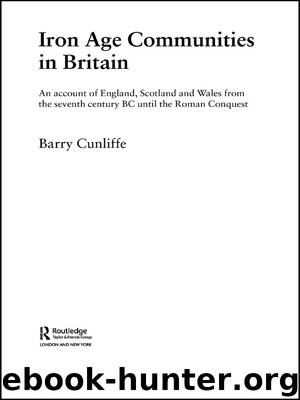Iron Age Communities in Britain by Cunliffe Barry W

Author:Cunliffe, Barry W.
Language: eng
Format: epub
Tags: ebook, book
Publisher: Taylor & Francis (CAM)
Published: 2011-11-15T16:00:00+00:00
Figure 15.5 The defensive ditch at Danebury, Hants (photograph: David Leigh, Danebury Trust).
At Maiden Castle six subsequent extensions and modifications all adopted the basic glacis style, and at Hod Hill there were three phases. Evidently the glacis was regarded as the ultimate in defensive tactics until the wide flat-bottomed ditches of Fécamp style were introduced in the first century AD (p. 402).
Multivallation
Superficial surface examination of the British hillforts shows that many of them were provided with more than one rampart and ditch; such forts are listed on the Ordnance Survey Map of Southern Britain in the Iron Age as multivallate. The term is confusing, however, for it covers several different situations. The multiple-enclosure forts of the south-west, while strictly multi- vallate, were so because extra lines of banks and ditches were required to enclose space for livestock. Other forts like Wandlebury, Cambs., Danebury, Hants, Bredon Hill, Worcs., the Caburn, Sussex, and Croft Ambrey, Heref. and Worcs., give the appearance of multivallation because of their growth or shrinkage and not necessarily from a general policy of extending the line of fire. Thus, surface assessment alone can seldom be decisive. Nevertheless, deliberate multivallation for the purpose of defence can be demonstrated on sites like Maiden Castle, Dorset, beginning in phase III and reaching its ultimate development in phase IV (Figure 15.6). At Hod Hill, Dorset, it is possible to trace the development of multivallation, starting in stage IIa (the first glacis remodelling) with the construction of a palisade in front of the ditch. Subsequently a second ditch was begun but not finished, the spoil being thrown up over the line of the palisade, which was now isolated between the two ditches. Whether or not the palisade belongs to stage IIa, the fact remains that multivallation came late in the development of the fort and, as the excavator has suggested, may have been initiated and subsequently abandoned at the time of the Roman advance in AD 43.
A somewhat similar situation occurred at Buckland Rings, Hants, where, in spite of large-scale levelling, it was possible to trace a fence outside the line of the inner ditch and in front of an outer ditch. No evidence of a rampart behind or sealing the fence-posts survived. At what stage the outer features were constructed it is impossible to say, but in all probability they were added to the original construction, and it is possible that the Buckland Rings sequence is a direct parallel to Hod Hill. The occurrence, at Moel y Gaer, of a palisade of timbers set in a shallow bank outside the ditch, which may be contemporary with the rampart, is a reminder that outer palisades may well prove to be more widespread than has hitherto been appreciated.
Generally it may be assumed that multivallation was a late development in most areas, sometimes – as at Hod Hill – not appearing until the first century AD but probably at least a century earlier at Maiden Castle and South Cadbury. At Rainsborough Camp, Northants, it has
Download
This site does not store any files on its server. We only index and link to content provided by other sites. Please contact the content providers to delete copyright contents if any and email us, we'll remove relevant links or contents immediately.
| Anthropology | Archaeology |
| Philosophy | Politics & Government |
| Social Sciences | Sociology |
| Women's Studies |
Mysteries by Colin Wilson(2893)
People of the Earth: An Introduction to World Prehistory by Dr. Brian Fagan & Nadia Durrani(2354)
Ancient Worlds by Michael Scott(2113)
Foreign Devils on the Silk Road: The Search for the Lost Treasures of Central Asia by Peter Hopkirk(2061)
The Memory Code by Lynne Kelly(1962)
Lost Technologies of Ancient Egypt by Christopher Dunn(1804)
The Splendid and the Vile by Erik Larson(1794)
Come, Tell Me How You Live by Mallowan Agatha Christie(1774)
The Earth Chronicles Handbook by Zecharia Sitchin(1759)
The Plantagenets by Dan Jones(1623)
Last Chance to See by Douglas Adams(1607)
The Return of the Gods by Erich von Daniken(1580)
Wars of the Anunnaki by Chris H. Hardy(1396)
Before the Dawn by Nicholas Wade(1318)
Keeper of Genesis by Graham Hancock(1283)
The Cygnus Mystery by Andrew Collins(1264)
The Message of the Sphinx by Graham Hancock(1229)
Fragile Lives by Stephen Westaby(1119)
Hieroglyphs: A Very Short Introduction by Penelope Wilson(1038)
